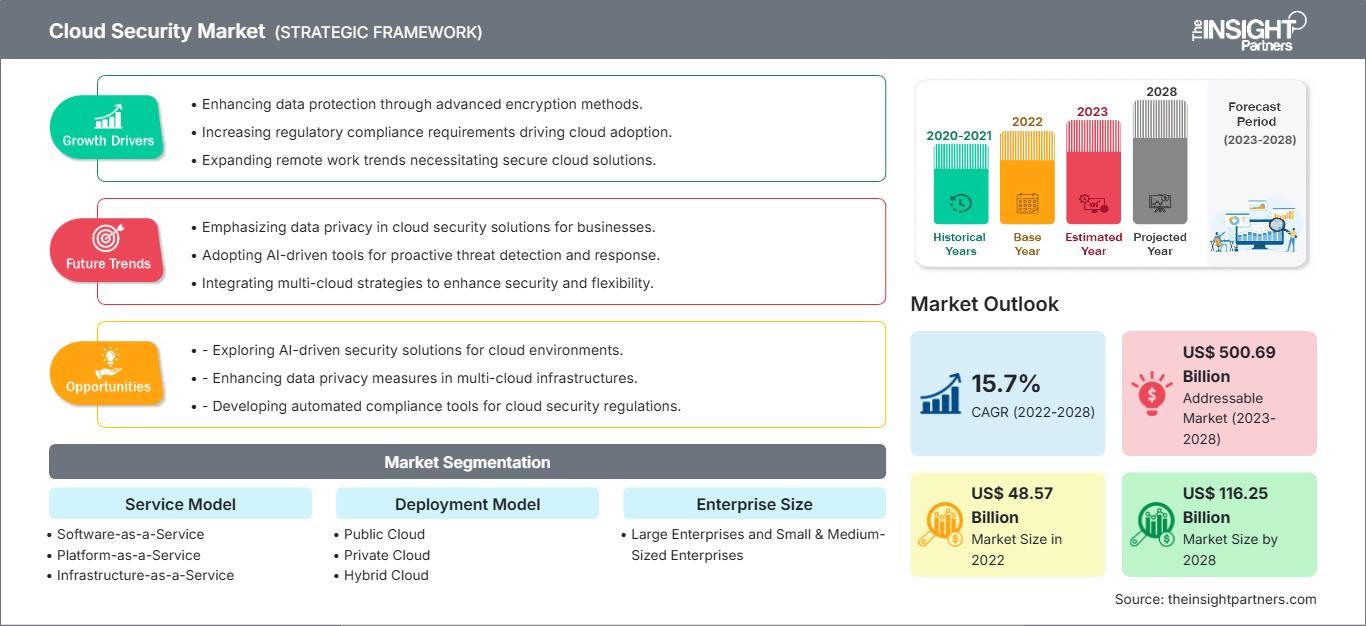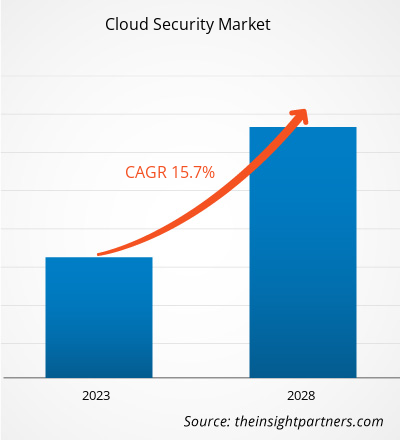Der Markt für Cloud-Sicherheit soll von 48,57 Milliarden US-Dollar im Jahr 2022 auf 116,25 Milliarden US-Dollar im Jahr 2028 wachsen; von 2022 bis 2028 wird ein durchschnittliches jährliches Wachstum von 15,7 % erwartet.
Die Aufrechterhaltung der Sicherheit ist für Unternehmen aufgrund der steigenden Zahl von Online-Sicherheitsverletzungen und technologischen Angriffen von entscheidender Bedeutung geworden. Cloud-Sicherheit bietet innerhalb der Netzwerkinfrastruktur zahlreiche Schutzebenen vor unbefugtem Zugriff, Datenverletzungen und Distributed-Denial-of-Service-Angriffen (DDoS). Im Jahr 2022 führte Flexera, ein amerikanisches Computersoftwareunternehmen, eine Studie durch und prognostizierte, dass fast 57 % der Unternehmen ihre Arbeitslasten in die Cloud verlagern. Außerdem haben fast 6 von 10 Unternehmen ihre Arbeit in die Cloud verlagert. Daher treibt die steigende Zahl von Unternehmen, die eine Cloud-basierte Infrastruktur nutzen, die Einführung von Cloud-Sicherheitslösungen voran.
Zu den großen, bekannten und finanzkräftigen Unternehmen in der globalen Cloud-Sicherheitsbranche gehören Amazon Web Services, Inc., Microsoft, IBM Corporation, Oracle und Google, Inc.. Aus diesem Grund ist die Verhandlungsmacht der Käufer auf dem Cloud-Sicherheitsmarkt recht hoch. Aufgrund des technologischen Fortschritts in der Cloud-Sicherheit und der stark zunehmenden Zahl verwalteter Containerdienste wird die Verhandlungsmacht der Käufer zwischen 2019 und 2028 voraussichtlich hoch bleiben. Die großen Unternehmen im Cloud-Sicherheitsmarkt verfolgen unterschiedliche Strategien bei der Planung von Lösungs- und Servicemodellen für verschiedene Branchen. Es wird erwartet, dass die kontinuierlichen Fortschritte im Technologiesektor die Cloud-Sicherheitsanbieter unter Druck setzen, sich an die Veränderungen anzupassen, um ihre Marktposition zu behaupten.
Passen Sie diesen Bericht Ihren Anforderungen an
Sie erhalten kostenlos Anpassungen an jedem Bericht, einschließlich Teilen dieses Berichts oder einer Analyse auf Länderebene, eines Excel-Datenpakets sowie tolle Angebote und Rabatte für Start-ups und Universitäten.
Markt für Cloud-Sicherheit: Strategische Einblicke

- Holen Sie sich die wichtigsten Markttrends aus diesem Bericht.Dieses KOSTENLOSE Beispiel umfasst Datenanalysen, die von Markttrends bis hin zu Schätzungen und Prognosen reichen.
Sie erhalten kostenlos Anpassungen an jedem Bericht, einschließlich Teilen dieses Berichts oder einer Analyse auf Länderebene, eines Excel-Datenpakets sowie tolle Angebote und Rabatte für Start-ups und Universitäten.
Markt für Cloud-Sicherheit: Strategische Einblicke

- Holen Sie sich die wichtigsten Markttrends aus diesem Bericht.Dieses KOSTENLOSE Beispiel umfasst Datenanalysen, die von Markttrends bis hin zu Schätzungen und Prognosen reichen.
Auswirkungen der COVID-19-Pandemie auf den Marktanteil von Cloud-Sicherheit
Der COVID-19-Ausbruch hatte auf seinem Höhepunkt im Jahr 2020 dramatische Auswirkungen auf die Weltwirtschaft und behinderte die Geschäftsaktivitäten in zahlreichen Branchen weltweit. Aufgrund von Reisebeschränkungen und Geschäftsschließungen kam es auch zu Betriebsunterbrechungen bei zahlreichen Firmen, Kunden und Partnern auf unbestimmte Zeit. Das Remote- und Hybrid-Arbeitsmodell verzeichnete aufgrund enormer Investitionen in die digitale Transformation einen rasanten Anstieg. Darüber hinaus kam es zu einer massiven Einführung von Cloud-Sicherheit, die durch die Pandemie, den Ausbau von Rechenzentren, staatliche Ausgaben für riesige Smart Cities und Projekte der öffentlichen Verwaltung zur Unterstützung der Einführung neuer Technologien in Unternehmen vorangetrieben wurde. Die Softwarebranche blieb von der Pandemie unberührt, da mehrere Unternehmen ihren Mitarbeitern die Arbeit von zu Hause aus ermöglichten. Darüber hinaus setzten Unternehmen zunehmend auf Cloud-Sicherheitslösungen und -Dienste, um den Personalbedarf für die Datenpflege zu reduzieren. Dadurch konnten sie ihre Belegschaft vor möglichen Infektionen schützen und gleichzeitig sicherstellen, dass die Produktion nicht beeinträchtigt wurde.
Markteinblick – Markt für Cloud-Sicherheit
Steigende Nutzung von Cloud-basierten Lösungen und Managed Security Services treibt Wachstum des Cloud-Sicherheitsmarktes an
Die Nachfrage nach Cloud-basierten Diensten stieg während der COVID-19-Pandemie aufgrund der weit verbreiteten Einführung des Homeoffice-Modells deutlich an. Microsoft verzeichnete 2021 einen Nachfrageanstieg von 775 % für seine Cloud-Service-Plattform. Kleine und mittlere Unternehmen (KMU) greifen auf Managed Security Services zurück, da ihnen das interne Fachwissen für eine effektive Verwaltung von Cloud-Diensten fehlt. Laut OTAVA ermöglichen ihnen diese Strategien, die Vorteile einer öffentlichen Cloud mit der Sicherheit einer privaten Cloud-Umgebung vor Ort zu kombinieren. Laut dem State of the Cloud Report 2020 von Flexera nutzen Unternehmen Cloud-Dienste, wobei 93 % von ihnen eine Multi-Cloud-Strategie verwenden und 87 % eine Hybrid-Cloud-Strategie bevorzugen. Es besteht eine bemerkenswerte Nachfrage nach Cloud-Sicherheitsdiensten, die von bedeutenden Cybersicherheitsanbietern wie Google, Microsoft und Amazon angeboten werden. Einige potenzielle Vorteile der Integration von Cloud Computing in die Verfahren und Abläufe von KMU sind vereinfachter Zugriff, schnelle Implementierung, geringer Bedarf an IT-Infrastruktur und niedrige Installationskosten.
Einblicke auf Basis von Bereitstellungsmodellen
Basierend auf dem Bereitstellungsmodell ist der Markt für Cloud-Sicherheit in öffentliche, private und hybride Clouds segmentiert. Im Jahr 2022 hatte das Segment der öffentlichen Cloud den größten Marktanteil im Bereich Cloud-Sicherheit. Unternehmen setzen in großem Umfang öffentliche Clouds über Cloud-Service-Provider (CSPs) von Drittanbietern ein, um Anwendungen und Daten innerhalb ihrer Infrastruktur zu verwalten. Darüber hinaus bieten wichtige Marktteilnehmer weiterhin integrierte Sicherheitstools an, die zum Schutz geschäftskritischer Daten beitragen. Öffentliche Cloud-Infrastrukturen sind für die breite Öffentlichkeit, Einzelpersonen und Unternehmen von großem Interesse, da sie Service-Skalierbarkeit bieten und den Verwaltungsaufwand für interne IT-Mitarbeiter verringern. Diese Faktoren treiben das Wachstum des Cloud-Sicherheitsmarktes im öffentlichen Cloud-Segment voran.
Akteure auf dem Cloud-Sicherheitsmarkt konzentrieren sich hauptsächlich auf die Entwicklung fortschrittlicher und effizienter Produkte.
- Im August 2022 führte VMware Inc. bedeutende Verbesserungen seiner einzigartigen lateralen Sicherheitsfunktionen ein, um Kunden dabei zu helfen, Sicherheit für moderne und traditionelle Anwendungen in Multi-Cloud-Umgebungen zu erreichen und so das Wachstum des Cloud-Sicherheitsmarktes anzukurbeln.
- Im Juni 2022 erweiterte Palo Alto Networks die Cloud-native Anwendungsschutzplattform um Funktionen wie kontextsensitive Softwarezusammensetzungsanalyse und Software-Stücklisten.
Cloud-SicherheitRegionale Einblicke in den Cloud-Sicherheitsmarkt
Die Analysten von The Insight Partners haben die regionalen Trends und Faktoren, die den Cloud-Sicherheitsmarkt im Prognosezeitraum beeinflussen, ausführlich erläutert. In diesem Abschnitt werden auch die Marktsegmente und die geografische Lage im Bereich Cloud-Sicherheit in Nordamerika, Europa, im asiatisch-pazifischen Raum, im Nahen Osten und Afrika sowie in Süd- und Mittelamerika erörtert.
Umfang des Marktberichts zur Cloud-Sicherheit
| Berichtsattribut | Einzelheiten |
|---|---|
| Marktgröße in 2022 | US$ 48.57 Billion |
| Marktgröße nach 2028 | US$ 116.25 Billion |
| Globale CAGR (2022 - 2028) | 15.7% |
| Historische Daten | 2020-2021 |
| Prognosezeitraum | 2023-2028 |
| Abgedeckte Segmente |
By Servicemodell
|
| Abgedeckte Regionen und Länder | Nordamerika
|
| Marktführer und wichtige Unternehmensprofile |
|
Dichte der Akteure auf dem Cloud-Sicherheitsmarkt: Auswirkungen auf die Geschäftsdynamik verstehen
Der Markt für Cloud-Sicherheit wächst rasant. Die steigende Nachfrage der Endnutzer ist auf Faktoren wie veränderte Verbraucherpräferenzen, technologische Fortschritte und ein stärkeres Bewusstsein für die Produktvorteile zurückzuführen. Mit der steigenden Nachfrage erweitern Unternehmen ihr Angebot, entwickeln Innovationen, um den Bedürfnissen der Verbraucher gerecht zu werden, und nutzen neue Trends, was das Marktwachstum weiter ankurbelt.

- Holen Sie sich die Markt für Cloud-Sicherheit Übersicht der wichtigsten Akteure
Der Markt für Cloud-Sicherheit ist in fünf Hauptregionen unterteilt: Nordamerika, Europa, Asien-Pazifik (APAC), Naher Osten und Afrika sowie Südamerika. Im Jahr 2022 führte Nordamerika den Markt mit einem beträchtlichen Umsatzanteil an, gefolgt von Europa. Darüber hinaus wird erwartet, dass der Asien-Pazifik-Raum von 2022 bis 2028 die höchste durchschnittliche jährliche Wachstumsrate (CAGR) verzeichnet.
Amazon Web Services, Inc.; Microsoft; IBM Corporation; Oracle; Trend Micro Incorporated; VMware, Inc.; Palo Alto Networks, Inc.; Cisco Systems, Inc.; Check Point Software Technologies Ltd.; und Google, Inc. gehören zu den wichtigsten Akteuren auf dem Markt für Cloud-Sicherheit. Der Marktbericht bietet detaillierte Markteinblicke, die den wichtigsten Akteuren helfen, das Wachstum in den kommenden Jahren zu planen.
- Historische Analyse (2 Jahre), Basisjahr, Prognose (7 Jahre) mit CAGR
- PEST- und SWOT-Analyse
- Marktgröße Wert/Volumen – Global, Regional, Land
- Branchen- und Wettbewerbslandschaft
- Excel-Datensatz
Aktuelle Berichte
Verwandte Berichte
Erfahrungsberichte
Grund zum Kauf
- Fundierte Entscheidungsfindung
- Marktdynamik verstehen
- Wettbewerbsanalyse
- Kundeneinblicke
- Marktprognosen
- Risikominimierung
- Strategische Planung
- Investitionsbegründung
- Identifizierung neuer Märkte
- Verbesserung von Marketingstrategien
- Steigerung der Betriebseffizienz
- Anpassung an regulatorische Trends




















 Kostenlose Probe anfordern für - Markt für Cloud-Sicherheit
Kostenlose Probe anfordern für - Markt für Cloud-Sicherheit